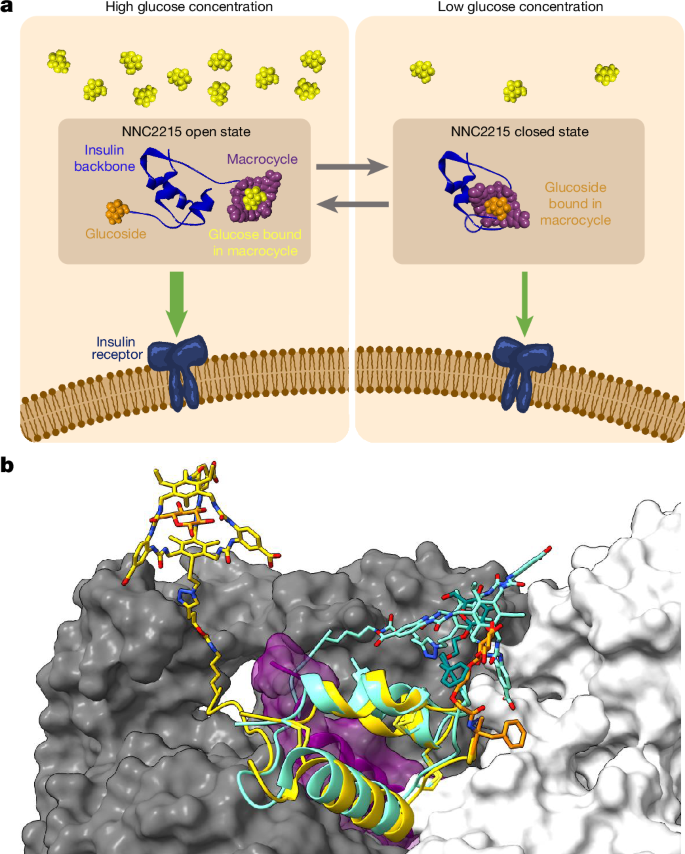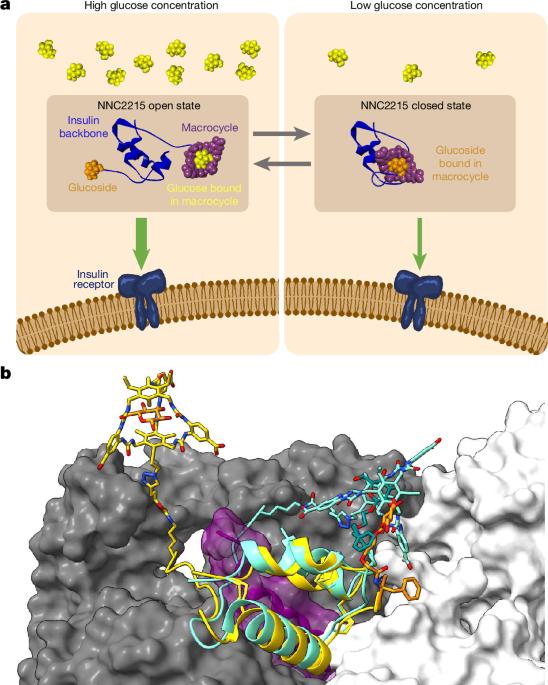对葡萄糖敏感的胰岛素,可减轻低血糖症状
IF 50.5
1区 综合性期刊
Q1 MULTIDISCIPLINARY SCIENCES
引用次数: 0
摘要
诱发低血糖(低血糖)的风险是胰岛素治疗糖尿病的主要挑战1,2。胰岛素剂量必须调整,以确保血糖值在正常范围内,但胰岛素剂量很难与波动的血糖水平相匹配,因为即使胰岛素剂量略高于需要,也会导致低血糖的发生,轻则令人不适,重则危及生命。因此,设计一种对葡萄糖敏感的胰岛素一直是我们的目标,这种胰岛素可以根据环境葡萄糖水平以可逆的方式自动调整其生物活性,最终实现更好的血糖控制,同时降低低血糖风险3。 我们在此报告 NNC2215 的设计和特性,这种胰岛素共轭物的生物活性可逆地响应与糖尿病相关的葡萄糖范围,这一点在体外和体内都得到了证实。NNC2215 是通过将一个葡萄糖结合大环4 和一个葡萄糖苷与胰岛素共轭而制成的,从而引入了一个开关,该开关可在葡萄糖作用下打开或关闭,从而使胰岛素在活性构象和低活性构象之间达到平衡。当葡萄糖浓度从 3 毫摩尔增加到 20 毫摩尔时,胰岛素受体对 NNC2215 的亲和力增加了 3.2 倍。在动物实验中,NNC2215 对葡萄糖敏感的生物活性被证明可防止低血糖症,同时部分抵消葡萄糖偏移。本文章由计算机程序翻译,如有差异,请以英文原文为准。


Glucose-sensitive insulin with attenuation of hypoglycaemia
The risk of inducing hypoglycaemia (low blood glucose) constitutes the main challenge associated with insulin therapy for diabetes1,2. Insulin doses must be adjusted to ensure that blood glucose values are within the normal range, but matching insulin doses to fluctuating glucose levels is difficult because even a slightly higher insulin dose than needed can lead to a hypoglycaemic incidence, which can be anything from uncomfortable to life-threatening. It has therefore been a long-standing goal to engineer a glucose-sensitive insulin that can auto-adjust its bioactivity in a reversible manner according to ambient glucose levels to ultimately achieve better glycaemic control while lowering the risk of hypoglycaemia3. Here we report the design and properties of NNC2215, an insulin conjugate with bioactivity that is reversibly responsive to a glucose range relevant for diabetes, as demonstrated in vitro and in vivo. NNC2215 was engineered by conjugating a glucose-binding macrocycle4 and a glucoside to insulin, thereby introducing a switch that can open and close in response to glucose and thereby equilibrate insulin between active and less-active conformations. The insulin receptor affinity for NNC2215 increased 3.2-fold when the glucose concentration was increased from 3 to 20 mM. In animal studies, the glucose-sensitive bioactivity of NNC2215 was demonstrated to lead to protection against hypoglycaemia while partially covering glucose excursions. NNC2215 is an insulin conjugate that can reversibly adjust its bioactivity in response to a diabetes-relevant glucose range in vivo.
求助全文
通过发布文献求助,成功后即可免费获取论文全文。
去求助
来源期刊

Nature
综合性期刊-综合性期刊
CiteScore
90.00
自引率
1.20%
发文量
3652
审稿时长
3 months
期刊介绍:
Nature is a prestigious international journal that publishes peer-reviewed research in various scientific and technological fields. The selection of articles is based on criteria such as originality, importance, interdisciplinary relevance, timeliness, accessibility, elegance, and surprising conclusions. In addition to showcasing significant scientific advances, Nature delivers rapid, authoritative, insightful news, and interpretation of current and upcoming trends impacting science, scientists, and the broader public. The journal serves a dual purpose: firstly, to promptly share noteworthy scientific advances and foster discussions among scientists, and secondly, to ensure the swift dissemination of scientific results globally, emphasizing their significance for knowledge, culture, and daily life.
 求助内容:
求助内容: 应助结果提醒方式:
应助结果提醒方式:


